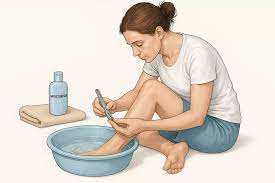A bunion, medically known as hallux valgus, is a bony bump that forms on the joint at the base of the big toe. This condition occurs when some of the bones in the front part of the foot move out of place, causing the tip of the big toe to get pulled toward the smaller toes. This forces the joint at the base of the big toe to stick out. Understanding the causes, symptoms, and treatment options available can help you determine the appropriate time to seek professional care. Here is more information on the causes and treatments of bunions:
What Causes Bunions?
Bunions can be caused by several things, like arthritis, ill-fitting shoes, or degenerative conditions. There is also a hereditary component. This means bunions can run in families due to an inherited foot structure that is prone to this condition. Foot stress from physical activities or injuries may also contribute to bunion formation.
While a visible bump is the primary sign, other symptoms may accompany a bunion, including:
- Swelling, Redness, or Soreness: Usually around your big toe joint.
- Corns or Calluses: Often form where the first and second toes rub against each other.
- Pain: Whether persistent or intermittent.
- Restricted Movements: Primarily of the big toe.
What Are the Treatments?
The treatment approach depends on the severity of the bunion and the level of discomfort it causes. Initial treatments are typically non-surgical and focus on relieving symptoms. These can include changing footwear to shoes with wider toe boxes, using padding to cushion the bunion, or placing orthotic shoe inserts to help position the foot correctly. Applying ice packs can help reduce swelling and pain.
If conservative treatments do not provide sufficient relief and the bunion interferes with daily activities, a medical professional may recommend surgery. Bunion surgery, or a bunionectomy, aims to realign the bone, ligaments, tendons, and nerves. This surgery returns the big toe to its correct position.
There are several types of surgical procedures, and a specialist can determine the most appropriate one for your specific situation. Other surgical options are:
- Arthrodesis
- Osteotomy
- Exostectomy
- Lapidus
When Should You Get Treatment?
Certain signs may indicate that it is time to consult a healthcare provider. If you experience persistent big toe or foot pain that affects your ability to walk or perform daily activities, you may benefit from a professional evaluation. You should also seek care if you have a visible bump on your big toe joint, decreased movement of your big toe or foot, or difficulty finding shoes that fit properly without causing pain. A medical evaluation from a podiatrist can confirm if you have bunions or another foot condition. A provider can assess the bunion’s severity and recommend a personalized treatment plan.
Schedule an Appointment Today
If bunion pain is affecting your quality of life, it may be time to explore medical options. Consulting with a podiatrist can provide clarity on your condition and help you understand the available treatment paths. Contact a provider today to schedule an appointment.














